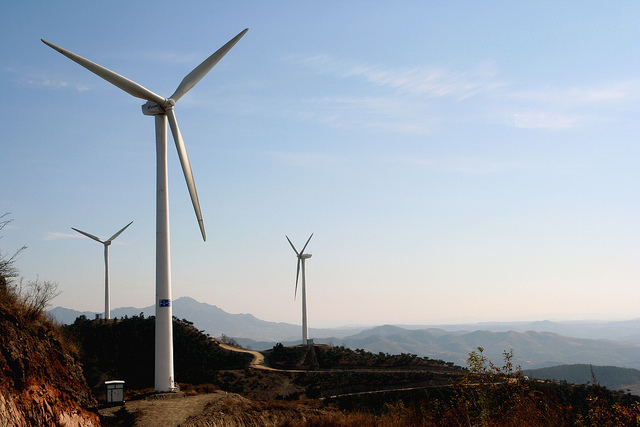2016年全球再生能源新增發電容量創新高,但投資金額比前一年低了23%。
根據聯合國環境署(UN Environment)、法蘭克福財經管理大學聯合國環境計畫署合作中心(Frankfurt School-UNEP Collaborating Centre)和彭博新能源財經(Bloomberg New Energy Finance,BNEF)合作發表的「全球再生能源投資趨勢」年度報告,2016年風力、太陽能、生質和垃圾焚化發電、地熱、小型水力和海洋發電共增加138.5GW發電量,等於全世界前16大發電廠的發電總和,比前一年(2015年)多8%。
2016年的投資總額下降至2416億美元,主要原因是成本降低,所需投資減少。不過投資額仍約是化石燃料的兩倍。
報告指出,太陽能和風力發電的每百萬瓦資本支出比前年降低超過10%。新增再生能源發電容量約佔2016年總新增發電容量的55%,比例創新高。根據報告,目前全球再生能源發電比例,不含大型水力發電,從10.3%增加到11.3%,減少1.7億噸的二氧化碳排放。
國際能源局(International Energy Agency)的資料顯示,溫室氣體排放量2014至2016連續三年持平,同時全球經濟成長3.1%,其中一個原因是再生能源發展。
風力和太陽能電廠資產購置金額也創下新高,來到727億美元。新增太陽能發電容量比去年高,新增風力發電容量則降低。投注於太陽能的新資金總額達1137億美元,比2015年的新高減少34%,但2016年的太陽能新發電容量仍達到歷史新高75GW。
風力去年吸引1125億美元投資,比前一年減少9%,新發電容量降至54GW,比前一年減少63GW。
雖然成本降低是投資金額減少的主因,報告指出中國、日本和其他新興市場的再生能源發展由於各種原因而趨緩。
中國打破連續11年的再生能源投資金額成長,2016年投資額下降32%至783億美元。美國再生能源業者由於賦稅抵減制度延長五年,開發步調趨緩,投資金額下降10%至464億美元。
墨西哥、致力、烏拉圭、南非和摩洛哥都減少60%以上,原因是電力需求成長趨緩,以及標售和融資延後。日本減少56%至144億美元。約旦是少數逆勢成長的市場,投資金額增加148%,來到12億美元。
BNEF諮詢委員會主委黎柏瑞(Michael Liebreich)說:「過去再生能源在電網上的競爭力一直是個問題。但這幾年成本大幅下降,不再需要補貼風力和太陽能的國家數量顯著成長,甚至可多達兩倍,開發中國家也不例外。現在有關當局不但不需要補貼再生能源,可能還要改補貼天然氣,以維持供電穩定。」
The world added record levels of renewable energy generating capacity in 2016, at an investment level 23 percent lower than the previous year, finds new research reported in the latest issue of “Global Trends in Renewable Energy Investment.”
Wind, solar, biomass and waste-to-energy, geothermal, small hydro and marine sources of power added 138.5 gigawatts to global power capacity in 2016, up eight percent from the year before.
The added generating capacity roughly equals that of the world’s 16 largest existing power producing facilities combined, according to the report issued Thursday by three institutions – UN Environment, the Frankfurt School-UNEP Collaborating Centre, and Bloomberg New Energy Finance, BNEF.
Investment levels in renewables fell in 2016. Less investment was needed due to falling costs.
The report shows that the average dollar capital expenditure per megawatt for solar photovoltaics and wind dropped by more than 10 percent compared to the previous year.
Investment in renewables capacity was roughly double that in fossil fuel generation, the report shows.
The new generating capacity from renewables was equivalent to 55 percent of all new power brought online in 2016, the highest proportion to date.
The proportion of the world’s electricity coming from renewables, excluding large hydro, rose from 10.3 percent to 11.3 percent. The report indicates that this prevented the emission of an estimated 1.7 gigatonnes of carbon dioxide.
Recent figures from the International Energy Agency cited the switch to renewables as one of the main reasons for greenhouse gas emissions staying flat in 2016, for the third year running, while output in the global economy rose by 3.1 percent.
The total investment in renewables last year was $241.6 billion due in large part to falling costs.
Purchases of assets such as wind farms and solar parks reached a new high, $72.7 billion.
Solar capacity additions rose last year, while wind capacity additions fell.
New investment in solar totalled $113.7 billion, down 34 percent from the record high in 2015. Even so, solar capacity additions in 2016 rose to an all-time high of 75 gigawatts.
Wind made up $112.5 billion of investment globally, down nine percent; wind capacity additions fell to 54 gigawatts from the previous year’s high of 63 gigawatts.
While much of the drop in financing was due to reduced technology costs, the report documented a slowdown in China, Japan and some emerging markets, for a variety of reasons.
China saw investment drop 32 percent to $78.3 billion, breaking an 11-year rising trend.
Mexico, Chile, Uruguay, South Africa and Morocco all saw falls of 60 percent or more, due to slower than expected growth in electricity demand, and delays to auctions and financings.
Japan slumped 56 percent to $14.4 billion.
Jordan was one of the few new markets to buck the trend; investment there rising 148 percent to $1.2 billion.
The United States saw commitments slip 10 percent to $46.4 billion, as developers took their time to build out projects to benefit from the five-year extension of the tax credit system.
“The question always used to be ‘will renewables ever be grid competitive?'” said Michael Liebreich, chairman of the Advisory Board at BNEF.
“Well, after the dramatic cost reductions of the past few years, unsubsidized wind and solar can provide the lowest cost new electrical power in an increasing number of countries, even in the developing world,” he said, “sometimes by a factor of two.”
“Instead of having to subsidize renewables, now authorities may have to subsidize natural gas plants to help them provide grid reliability.”
※ 全文及圖片詳見:ENS









